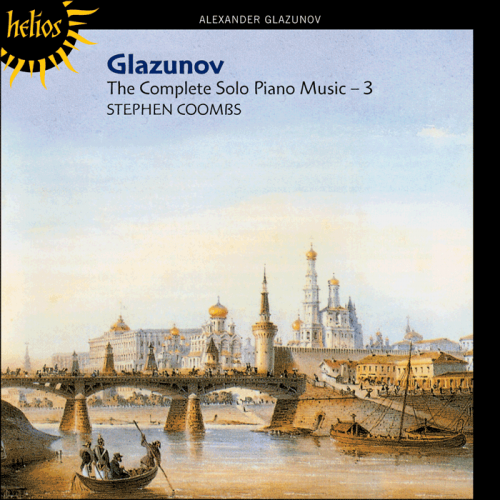
Stephen Coombs - Alexander Glazunov: Piano Music Vol. 3 (1995)
BAND/ARTIST: Stephen Coombs
- Title: Alexander Glazunov: Piano Music Vol. 3
- Year Of Release: 1995
- Label: Hyperion
- Genre: Classical
- Quality: FLAC (Tracks)
- Total Time: 01:00:21
- Total Size: 174 mb (+3%rec.)
- WebSite: Album Preview
With the incredible popularity of Bach’s Well Tempered Clavier, every pianist since the middle of the eighteenth century has learned to play it, learned to play by means of it. The temptation to try to imitate the master has for most of them proven to be irresistible. In fact Beethoven, Schubert, Liszt, and Wagner seem to be the only notable exceptions. Mozart, Mendelssohn, Chopin, Tchaikovsky, Brahms, Rachmaninov, Taneyev, Respighi, Vaughan Williams, and Shostakovich all tried their hand. A few stopped at the writing of Preludes,* writing few if any fugues to follow, and some wrote many more fugues than preludes. One reason why such pieces have not been played frequently is that during the Victorian era they were considered "mere" exercises, to be sharply distinguished from those "inspired" compositions where God entered the composing process and dictated the music, compositions where the composer’s immortal soul could shine forth unencumbered by pedantic artifice and fussy intellectualism. I’m not making this up, you know.
But, pedantic artifice and fussy intellectualism or no, I have always been fascinated by these Bach imitations, not slightly because they are in many cases rather good music, or at the very least fascinating in the insight they give as to how Bach appeared to later generations.
Since one hears very little of Glazunov’s piano music, it is surprising that it is so good, receiving here the benefit of exceptionally beautiful performances and recordings. The Op. 62 is a substantial work, perhaps the most accessible of the set. You can download the score from www.sheetmusicarchive.net. The remaining works require listening through a few times to reveal their wonders. The preludes feature extensive runs and arpeggiation. The fugue subjects feature stepwise harmonies which lead to much parallel and contrary motion chromatic passage-work during the working out, so the overall shape of the music is much like that of Rachmaninov. Quoting Shostakovich, the notes say Glazunov was a committed contrapuntalist in developing his orchestral textures. But he was not really a fugue writer like Tchaikovsky or Taneyev, but more a creator of well woven sonic tapestries like Schubert or Rachmaninov. Glazunov’s fugues contain much broken counterpoint, little canon, and rely a lot on transitions and episodes.
*Before you put Chopin entirely in this category you should hear his Prelude and Fugue in a minor played on the harpsichord.
-- Paul Shoemaker, MusicWeb International
Tracks:
(01-02) Prelude and Fugue in D minor, Op. 62
(03-10) Four Preludes and Fugues Op. 101, Nos. 1-4
(11-12) Prelude and Fugue in E minor
Personnel:
Stephen Coombs, piano
But, pedantic artifice and fussy intellectualism or no, I have always been fascinated by these Bach imitations, not slightly because they are in many cases rather good music, or at the very least fascinating in the insight they give as to how Bach appeared to later generations.
Since one hears very little of Glazunov’s piano music, it is surprising that it is so good, receiving here the benefit of exceptionally beautiful performances and recordings. The Op. 62 is a substantial work, perhaps the most accessible of the set. You can download the score from www.sheetmusicarchive.net. The remaining works require listening through a few times to reveal their wonders. The preludes feature extensive runs and arpeggiation. The fugue subjects feature stepwise harmonies which lead to much parallel and contrary motion chromatic passage-work during the working out, so the overall shape of the music is much like that of Rachmaninov. Quoting Shostakovich, the notes say Glazunov was a committed contrapuntalist in developing his orchestral textures. But he was not really a fugue writer like Tchaikovsky or Taneyev, but more a creator of well woven sonic tapestries like Schubert or Rachmaninov. Glazunov’s fugues contain much broken counterpoint, little canon, and rely a lot on transitions and episodes.
*Before you put Chopin entirely in this category you should hear his Prelude and Fugue in a minor played on the harpsichord.
-- Paul Shoemaker, MusicWeb International
Tracks:
(01-02) Prelude and Fugue in D minor, Op. 62
(03-10) Four Preludes and Fugues Op. 101, Nos. 1-4
(11-12) Prelude and Fugue in E minor
Personnel:
Stephen Coombs, piano
As a ISRA.CLOUD's PREMIUM member you will have the following benefits:
- Unlimited high speed downloads
- Download directly without waiting time
- Unlimited parallel downloads
- Support for download accelerators
- No advertising
- Resume broken downloads


